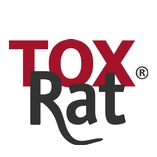Comments appreciated...
toxrat@toxrat.com or here: https://www.linkedin.com/company/toxrat/
Oct 25: EFSA Bee Guidance & ToxRat – still a hot topic!
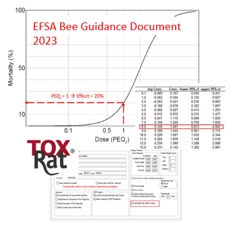
We continue to receive many questions on how to apply ToxRat within the context of EFSA’s Guidance Document on bee risk assessment – especially when it comes to calculating the PIE (Predicted Individual Effect) for a given PEQ (Predicted Environmental Quantity) using dose-response regression models.
To support users, in July 24, we’ve presented a suggestion how ToxRat can be used for this purpose - without doing any maths and including a measure for uncertainty - which we would like to recall here.
Additionally, we commented on the EFSA´s suggestion, to use the dose-response model function of a regression to back-calculate the PIE for a certain PEQ and would like to show you which mistake you should avoid in any case
To this end, we have developed a tool that implements the EFSA proposal - but based on linear regression instead of non-linear regression.
Just try it! Please make use of our browser-application for demo data.
Are you already a ToxRat user? If so, we will be happy to send you the tool as an Excel file as part of your service contract - just send us an e-mail.
July 2025: Paper about 4-parameter nonlinear regression published

We are happy to announce that our paper
Four-parameter nonlinear regression and maximum achievable effect in ecotoxicology: Just visually appealing or relevant for risk assessment?
has been published: https://doi.org/10.1093/inteam/vjaf085
A pdf can be downloaded here:
May 2025: SETAC Europe Conference in Vienna

Three days of non-stop discussions at our exhibition stand, plus plenty of input from numerous presentations and discussions – it was exhausting, but extremely rewarding.
On Tuesday, Benjamin Daniels presented our latest poster on the topic of
4-parameter non-linear regression. Further information and download link:
4-Parameter nonlinear regression

ECx determination by regression is challenging, data is not always perfect.
Sometimes, 4-parameter-regression results in an amazingly good fit.
But is this just visually appealing or is it relevant for risk assessment?
In a poster presented at the SETAC Conference in Vienna, we
- demonstrate when it is appropriate to use 4PR and when it is not,
- show that 4PR enables calculation of two different types of ECx: absolute and relative ones,
- analyze how absolute and relative ECx can differ and what factors influence these differences,
- present characteristics and consequences of absolute and relative ECx.
We do not advocate for either absolute or relative ECX derived from 4PR, but highlight the implications of each to facilitate informed decision-making.
Future guidelines should specify which type of ECX should be reported for each variable to ensure consistency and clarity in data interpretation.
A corresponding paper has been accepted for publication by IEAM (Integrated Environmental Assessment and Management).
Avalaible for download: Poster
Outlook May 2025: Meet ToxRat in Vienna

ToxRat is part of the SETAC Europe Conference in Vienna, 11. - 15. May 2025.
Any questions about the software, statistics at all, or do you just want to meet us in person?
We can arrange appointments on request or you are welcome to drop in: Booth Nr. 50!
(SETAC Europe Conference)!
May 2024: Sevilla

With more than 3,000 participants, the SETAC Europe Conference held in Seville from the 5th to the 9th of May 2024 was very special and the largest ever. It was nice to see a lot of familiar faces again and a warm welcome to our new contacts :-)
Jan 2024: Deriving a PIE for a PEQ using ToxRat
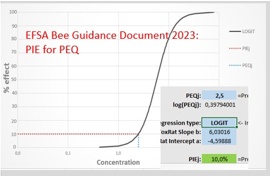
The EFSA Bee Guidance Document (2023) suggests using the dose-response function of a regression model to determine a PIE (Predicted Individual Effect) for a PEQ (Predicted Environmental Quantity).
We would like to show you which mistake you should avoid in any case - and how the EFSA requirement can also be realised with ToxRat.
To this end, we have developed a tool that implements the EFSA proposal - but based on linear regression instead of non-linear regression.
Read more:
Just try it!
Please make use of our browser-application for demo data.
Are you already a ToxRat user? If so, we will be happy to send you the tool as an Excel file as part of your service contract - just send us an e-mail.
By the way: PIE determination is also possible without doing any maths - see our article below from July 23.
Jan 2024: The role of "maximum achievable effect" in ECx calculation.
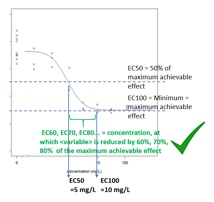
Recently, the question of the "maximum achievable effect" in the calculation of ECs has been addressed by several users and it was claimed that ToxRat is calculating incorrectly.
Therefore, we would like to clarify, how this issue is adressed in guidelines and in literature, what does this mean for 4-parameter non-linear regressions, what is the consequence if ECx are not related to the “maximum achievable effect”, and how this is handled in ToxRat.
Please note: The information applies regardless of the software used!
July 2023: How to get a PIE from PEQ using ToxRat
.

The new Bee Guidance document from EFSA suggests to use the dose-response model function of a regression to back-calculate the PIE (Predicted Individual Effect) from a certain Predicted Environmental Quantity (PEQ).
We are being asked about this more frequently, therefore, we´d like to comment on the possibilities of ToxRat in this context.
June 2023: Finally - Guidance for ring test statistics with biotests
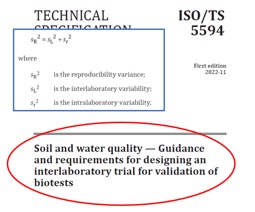
The only guideline available so far for the statistical evaluation of interlaboratory comparisons (ISO 5725) is intended for chemical-physical measurement methods. Therefore, essential characteristics of biotests in ecotoxicology were not considered.
This gap is now closed by the new ISO document ISO/TS 5594: 2022 (E) (contribution: Toni Ratte, Benjamin Daniels).
The ISO 5594 provides
- normative advice on how to deal with log-normally distributed toxicity metrics in ecotoxicity testing
- a method to calculate the intra-laboratory variability, even if the participating laboratories are not working under repeatability conditions
- guidance on how to calculate the uncertainty of reproducibility when fewer than six valid data sets are obtained.
We are pleased that our approach to the statistical evaluation of interlaboratory comparisons in ecotoxicology has now been officially confirmed.
May 2023: Thank you, Dublin!
Thank you to numerous visitors of our exhibition booth at the SETAC Europe Conference in Dublin from 30 April - 4 May 2023.
It was a great pleasure to meet you, to discuss with you and to get your feedback. We will keep in touch!

.
May 2023: Results of our latest statistical evaluation...
... are presented on a poster at the SETAC Europe Conference in Dublin from 30 April - 4 May 2023:
"A comprehensive laboratory comparison for generating data for green algae response to time-variable exposures"
Bruns et al (2023)
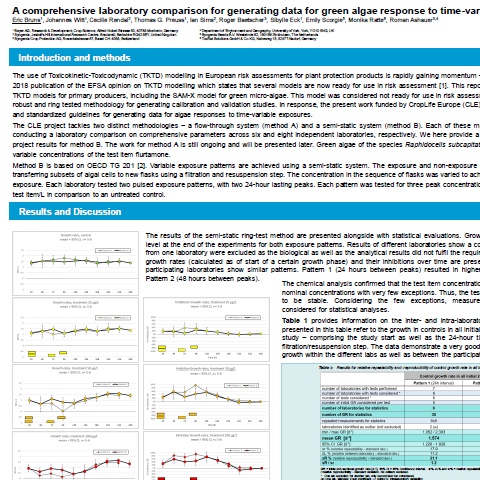
.
Outlook to May 2023: Let's meet in Dublin
ToxRat is exhibitor at the SETAC Europe Conference in Dublin from 30 April - 4 May 2023.
Take the opportunity to meet the ToxRat team in person, to have your questions answered or to get a live demonstration of the software.
We can arrange appointments on request, or you are welcome to drop by at any time: booth no. 52!
(SETAC Europe Conference)
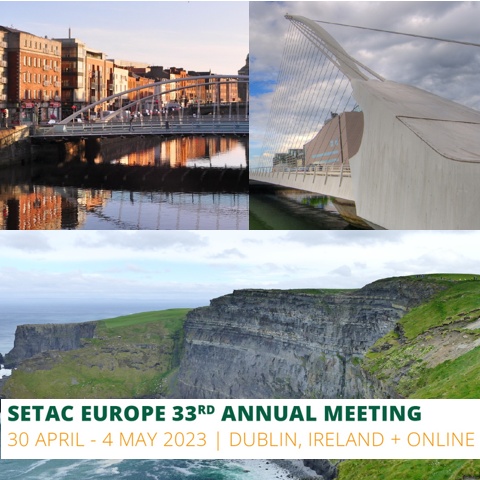
.
December 2022 - A brief look back to 2022: time for interactions.
It's hard to believe that less than a year ago we were still busy relaunching our website.
In the meantime, the new ToxRat look is a matter of course and the cooperation of our new colleague Dr. Benjamin Daniels is an essential part of our daily work.
Thanks to this new constellation, we were able to complete the programming of new methods this year (RSCABS, MQJT, CPCAT). The offer to carry out evaluations for users is already being used frequently.
We are also pleased about increased demand for our statistics courses and our expertise for the statistical evaluation of biotests in various boards or by requests for evaluations or statements.
This makes us optimistic about 2023 - a little preview: see you at thew SETAC Conference in Dublin in May!

May 2022 - A reunion in Copenhagen
After two years without a physical meeting, the SETAC Europe conference in Copenhagen from May 15 - 19, 2022 was a delightful opportunity to refresh old contacts and make new ones. Many thanks to all business partners, ToxRat users, colleagues and interested parties for the many stimulating conversations and the positive response to our new exhibition booth!
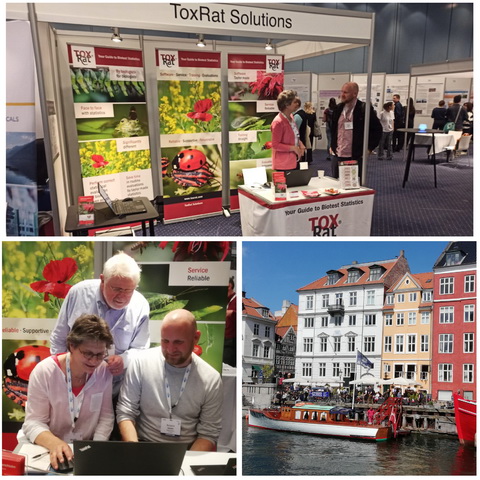
May 2022
Statistical Evaluation of "Plant Injury" or "Developmental stages" (AMA, OECD 231)
We have implemented test methods for ordinal data into ToxRat: the Rao Scott Cochran Armitage Test by Slices (RSCABS) and the Multiquantal Jockheere Terpstra Test (MQJT) (Green et al.: Statistical Analysis of Ecotoxicity Studies, 2018).
They will be generally available with the Update 4.0. However, due to the urgency for many users, we are making the data entry templates for RSCABS and MQJT available starting immediately.
The procedure is as follows:
You receive an appropriate template, enter your raw data and submit it to us (anonymous data is also possible).
We evaluate your data for you and create the usual ToxRat evaluation tables and report.
This service is free of charge for users with a service contract.
For all other users, we will be happy to make you an individual offer.
If you are interested, please contact us!
2002 - 2022: 20 years ToxRat
New look, new partner, many new ideas - and proven content.
In the beginning there was an idea.
2002 to 2022 = 20 years of ToxRat! We are pleased, grateful for the trust of many customers and business partners, and also a little proud of what the idea ("There is a need for an interface between statistics and ecotoxicology") has become.
But: We do not want to rest on our laurels!
We want the ToxRat story to continue. That is why we have strengthened our team. Dr. Benjamin Daniels will ensure competence and continuity in the sense of the proven ToxRat philosophy. And he stands for further development, new ideas and growth.
New Look
Our new website leaves no doubt that ToxRat's roots are in biology.
And who says that the combination of statistics and biology can't be fun?
Therefore "just for fun" a little poll: Which photo / slogan on our website is your personal favorite?
Tell us!
https://www.linkedin.com/company/toxrat/
Future prospects
The ToxRat future starts with our new website and will be continued later with the software version ToxRat 4.0.
As always, we will keep you informed about various other plans and the current state via customer info and on this website.
Please visit us again!
December 2021
The current alert in the IT world regarding Log4 shell security vulnerability has led to enquiries as to what extent ToxRat is affected, i.e. whether the widely used Java library Log4j is used in ToxRat.
The unequivocal answer is: ToxRat is programmed in Delphi, the Java library Log4j is not used in ToxRat.
Furthermore: ToxRat is a completely independent stand-alone software that is installed locally at the user's site. When the programme is started, there is no communication with other software programmes or externally. ToxRat even does not require internet access for operation.
This is a clear advantage compared to cloud-based applications in terms of IT security.
We hope that this information will support our users' internal measures regarding the Log4 shell security vulnerability.
October 2021
The demand for training is increasing - and the online format not only saves time and money for all involved, but also offers more flexibility, e.g. courses can easily be split into two half days. We put the travel time saved into even more customization to meet the needs of the participants. We are very pleased with the response and feel confirmed to continue on this path:
"Firstly, please allow me to send a HUGE THANK YOU! for the wonderful training. I was just getting some feedback from the team, and this will really add a lot of value to their work and indeed be positive for our clients so please accept my sincere thanks for delivering this so well and in a tailored fashion. It’s a very hard subject to deliver and everyone was really positive about the content and how it was delivered."
“It was really clear. Good to see a statistician with great communication skills for the non-statisticians.”
"I wanted to express my thanks to you for organizing this very helpful training. It had been having impact on our work from Day 1 😊. In any case, do keep this up!"
May 2021
ToxRat sets the course for the future!
actually, we hoped to meet users, business partners and colleagues - that is YOU - at the upcoming annual SETAC meeting in May.
However – this will not work due to the ongoing pandemic. This means: One more year without personal contact, face-to-face discussions and keeping you up to date about our plans.
That is a great pitty – since indeed, we have a lot of plans and ideas. For some time now we have been dealing with the question: How to set the course for ToxRat´s future? Let me briefly tell you the most important aspects:
April 2021
News on NOEC determination
A recently published paper confirms the relevance of CPCAT for the analysis of count data:
Daniels, B., Roß‐Nickoll, M., Jänsch, S., Pieper, S., Römbke, J., Scholz‐Starke, B. and Ottermanns, R. (2021), Application of the Closure Principle Computational Approach Test to Assess Ecotoxicological Field Studies: Comparative Analysis Using Earthworm Field Test Abundance Data. Environ Toxicol Chem
DOI https://doi.org/10.1002/etc.5015
The CPCAT will be implemented in the next ToxRat update.
Further information can also be found here:
Lehmann et al. 2018: https://doi.org/10.1186/s12302-018-0178-5
Lehmann et al. 2016: https://link.springer.com/article/10.1007/s00477-015-1079-4
December 2020
Challenge as a chance
Admittedly - it took some to get used to it. But certainly, the online format has proven to be very successful also in user support. Any questions regarding ToxRat?
See you :-)
July 2020
Seminars and Trainings 2.0
We changed our seminars and trainings to online format. Initial experiences with online training were very positive, so we are now expanding and continuing this format. Please contact us if you are interested!
May 2020
ToxRat, Corona and the SETAC Europe Annual Meeting, Dublin
Due to measures against the coronavirus, the SETAC Europe 30th Annual Meeting on 3-7 May will be held in the virtual space.
We fully agree with this decision and greatly appreciate the immense efforts of the organizers, to bear this extraordinary challenge on such short notice.
Please read our message to visitors of the virtual exhibition here.
We wish SETAC and all participants great success at the virtual meeting!
Hope to see you again soon. Take care!
November 2019
Guideline developement for Glyceria maxima and ringtesting is still going on. A poster presented at the SETAC North America Meeting, Totonto, shows the current state and answers the question, whether root variables are appropriate endpoints.
July 2019
From 2019 to 2022, ToxRat will again participate in a project of the German Federal Environment Agency (Umweltbundesamt) investigating the toxicity and environmental compatibility of construction products for outdoor applications.
Further information is available here (in German):
Methoden und Kriterien zur Bewertung der Ökotoxizität von Bauprodukten
May 2019
ToxRat is again an exhibitor at the SETAC-Europe-Annual Meeting, which will be held from May 26-30 in Helsinki, Finnland. We are looking forward to meeting you (again) at booth no 22.
January 2019
New training course: Statistical Power Analysis
Since January, we are offering additional training courses about statistical power analysis and experimental designs of ecotoxicological semi-field and field studies.
The course introduces theoretical principles of hypothesis testing, a-priori considerations for sound experimental designs and measures of after-the-fact reliability of study results. Beyond theory, the focus lies on practical exercises using open-source software tools and gives room for discussion of the specific problems of the participants. For this reason, using your own data is highly welcome. As usual, the specific contents might be customized. Just let us know your needs!
December 2018
To be continued: News regarding NOEC-determination from reproduction data
René Lehmann, Jean Bachmann, Bilgin Karaoglan, Jens Lacker, Glenn Lurman, Christian Polleichtner, Hans Toni Ratte and Monika Ratte (2018):
The CPCAT as a novel tool to overcome the shortcomings of NOEC/LOEC statistics
in ecotoxicology: a simulation study to evaluate the statistical power.
Environ Sci Eur (2018) 30:50
https://doi.org/10.1186/s12302-018-0178-5
